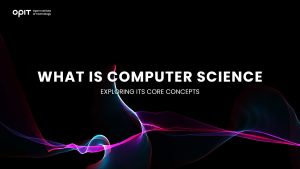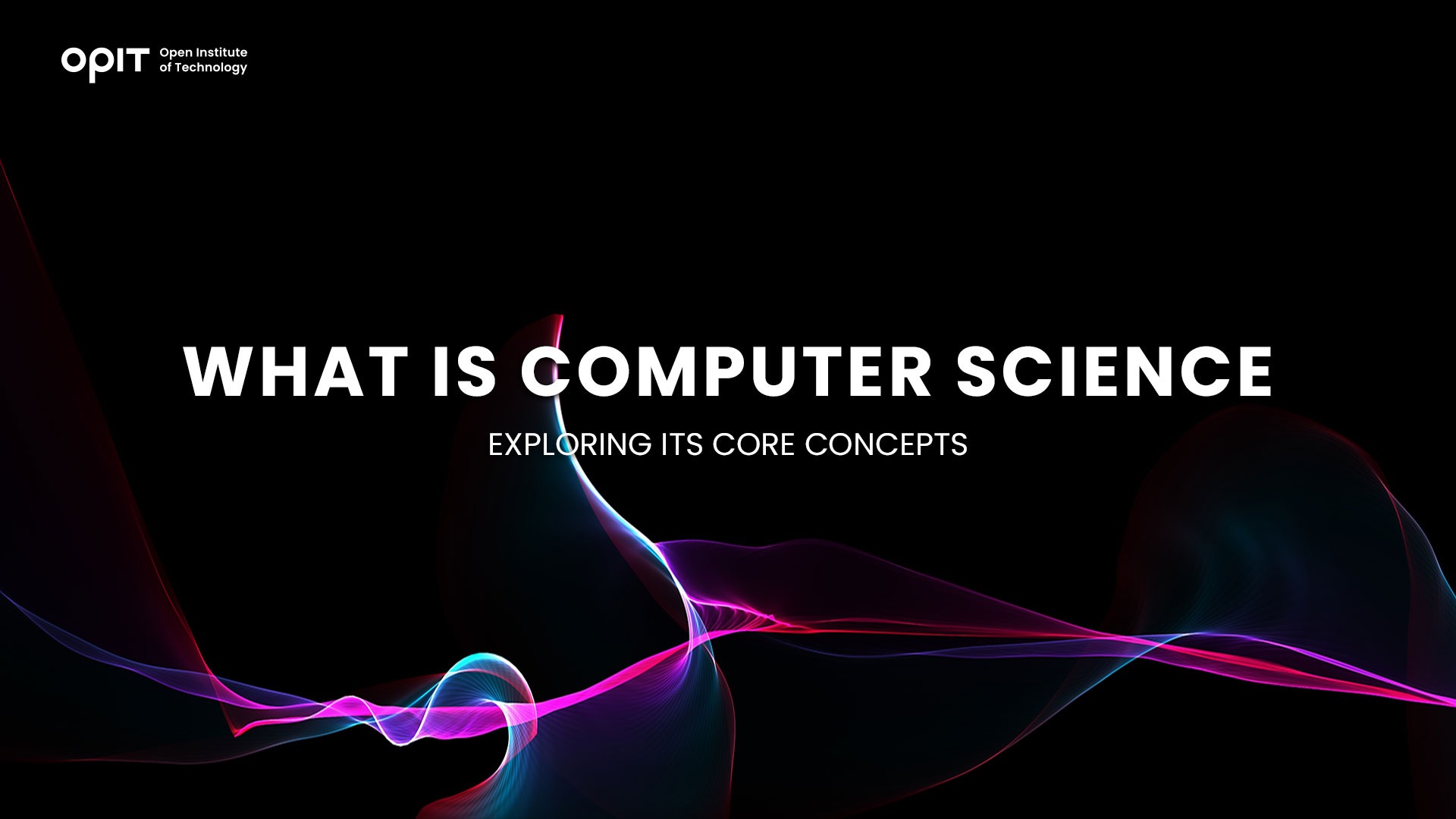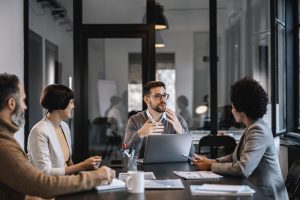

Large portions of modern life revolve around computers. Many of us start the day by booting a PC and we spend the rest of our time carrying miniaturized computer devices around – our smartphones.
Such devices rely on complex software environments and programs to meet our personal and professional needs. And computer science deals with precisely that.
The job of a computer scientist revolves around software, including theoretical advances, software model design, and the development of new apps. It’s a profession that requires profound knowledge of algorithms, AI, cybersecurity, mathematical analysis, databases, and much more.
In essence, computer science is in the background of everything related to modern digital technologies. Computer scientists solve problems and advance the capabilities of technologies that nearly all industries utilize.
In fact, this scientific field is so broad that explaining what is computer science requires more than a mere definition. That’s why this article will go into considerable detail on the subject to flesh out the meaning behind one of the most important professions of our time.
History of Computer Science
The early history of computer science is a fascinating subject. On the one hand, the mechanics and mathematics that would form the core disciplines of computer science far predate the digital age. On the other hand, the modern iteration of computer science didn’t start until about two decades after the first digital computer came into being.
When examining the roots of computer science, we can go as far back as the antiquity era. Mechanical calculation tools and advanced mathematical algorithms date back millennia. However, those roots are too loosely connected to computer science.
The first people who started exploring the foundations of what is computer science today were Wilhelm Schickard and Gottfried Leibniz in early and late 17th century, respectively.
Schickard is responsible for the design of the world’s first genuine mechanical calculator. Leibniz is the inventor of a calculator that worked in the binary system, the universally known “1-0” number system that paved the way for the digital age.
Despite the early advances in the mentioned fields, it would be another 150 years after Leibniz before mechanical and automated computing machines saw industrial production. Yet, those machines weren’t used for any other purpose apart from calculations.
Computers became more powerful only in the 20th century. Like many other technologies, this branch saw rapid development during the last one hundred years, with IBM creating the first computing lab in 1945.
Yet, while plenty of research was happening, computer science wasn’t established as an independent discipline. That would take place only during the 1960s.
Early Developments
As mentioned, the invention of the binary system could be considered a root of computer science. This isn’t only due to the revolutionary mathematical model – it’s also because the binary number system lends itself particularly well to electronics.
The rise of electrical engineering moved forward inventions like the electrical circuit, the transistor, and powerful data storage solutions. This progress gave birth to the earliest electrical computers, which mostly found use in data processing.
It didn’t take long for massive companies to start using the early computers for information storage. Naturally, this use made further development of the technology necessary. The 1930s saw crucial milestones in computer theory, including the groundbreaking computational model by Alan Turing.
Not long after Turing, John von Neumann created a model of a computer that can store programs. By the 1950s, computers were in use in complex calculations and data processing on a large scale.
The rising demand made the binary machine language too unreliable and impractical. The successor, the so-called assembly language, soon proved just as lacking. By the end of the decade, the world saw the first program languages, which soon became the famed FORTRAN (Formula Translation) and COBOL (Common Business Oriented Language).
The following decade, it became obvious that computer science is a field of study in itself, rather than a subset of mathematical or physical disciplines.
Evolution of Computer Science Over Time
As technology kept progressing, computer science needed to keep up. The first computer operating systems came about in the 1960s, while the next two decades brought about an intense expansion in graphics and affordable hardware.
The combination of these factors (OS, accessible hardware, and graphical development) led to advanced user interfaces, championed by industry giants like Apple and Microsoft.
In parallel to these discoveries, computer networks were advancing, too. The birth of the internet added even more moving parts to the already vast field of computer science, including the first search engines that utilized advanced algorithms, albeit not at the same level as today’s engines.
Furthermore, greater computational capabilities created a need for better storage systems. This included larger databases and faster processing.
Today, computer science explores all of the mentioned facets of computer technology, alongside other fields like robotics and artificial intelligence.
Key Areas of Study in Computer Science
As you’ve undoubtedly noticed, computer science grew in scope with the development of computational technologies. That’s why it’s no surprise that computer science today encompasses many areas that deal with every aspect of the technology currently imaginable.
To answer the question of what is computer science, we’ll list some of the key areas of this discipline:
- Algorithms and data structures
- Programming languages and compilers
- Computer architecture and organization
- Operating systems
- Networking and communication
- Databases and information retrieval
- Artificial intelligence and machine learning
- Human-computer interaction
- Software engineering
- Computer graphics and visualization
As is apparent, these areas correspond with the historical advances in computational technology. We’ve talked about how algorithms predate the modern age by quite a lot. These mathematical achievements brought about early machine languages, which turned into programming languages.
The progress in data storage and the increased scope of the machines resulted in a need for more robust architecture, which necessitated the creation of operating systems. As computer systems started communicating with each other, better networking became vital.
Work on information retrieval and database management resulted from both individual computer use and a greater reliance on networking. Naturally, it didn’t take long for scientists to start considering how the machines could do even more work individually, which marked the starting point for modern AI.
Throughout its history, computer science developed new disciplines out of the need to solve existing problems and come up with novel solutions. When we consider all that progress, it’s clear that the practical applications of computer science grew alongside the technology itself.
Applications of Computer Science
Computer science is applied in numerous fields and industries. Currently, computer science contributes to the world through innovation and technological development. And as computer systems become more advanced, they are capable of resolving complex issues within some of the most important industries of our age.
Technology and Innovation
In terms of technology and innovation, computer science finds application in the fields of graphics, visualization, sound and video processing, mathematical modeling, analytics, and more.
Graphical rendering helps us visualize concepts that would otherwise be hard to grasp. Technologies like VR and AR expand the way we communicate, while 3D models flesh out future projects in staggering detail.
Sound and video processing capabilities of modern systems continue to revolutionize telecommunications. And, of course, mathematical modeling and analytics expand the possibilities of various systems, from physics to finance.
Problem-Solving in Various Industries
When it comes to the application of computer science in particular industries, this field of study contributes to better quality of life by tackling the most challenging problems in key areas:
- Healthcare
- Finance
- Education
- Entertainment
- Transportation
Granted, these aren’t the only areas where computer science helps overcome issues and previous limitations.
In healthcare, computer systems can produce and analyze medical images, assisting medical experts in diagnosis and patient treatment. Furthermore, branches of computer science like psychoinformatics use digital technologies for a better understanding of psychological traits.
In terms of finance, data gathering and processing is critical for massive financial systems. Additionally, automation and networking make transactions easier and safer.
When it comes to education and entertainment, computer science offers solutions in terms of more comprehensible presentation, as well as more immersive experiences. Many schools worldwide use digital teaching tools today, helping students grasp complex subjects with fewer obstacles compared to traditional methods.
Careers in Computer Science
As should be expected, computer science provides numerous job opportunities in the modern market. Some of the most prominent roles in computer science include systems analysts, programmers, computer research scientists, database administrators, software developers, support specialists, cybersecurity specialists, and network administrators.
The mentioned roles require a level of proficiency in the appropriate field of computer science. Luckily, computer science skills are easier to learn today – mostly thanks to the development of computer science.
An online BSc or MSc in computer science can be an excellent way to get prepared for a career in the most sought-after profession in the modern world.
On that note, not all computer science jobs are projected to grow at the same rate by the end of this decade. Profiles that will likely stay in high demand include:
- Security Analyst
- Software Developer
- Research Scientist
- Database Administrator
Start Learning About Computer Science
Computer science represents a fascinating field that grows with the technology and, in some sense, fuels its own development. This vital branch of science has roots in ancient mathematical principles as well as the latest advances like machine learning and AI.
There are few fields worth exploring more today than computer science. Besides understanding our world better, learning more about computer science can open up incredible career paths and provide an opportunity to contribute to resolving some of the burning issues of our time.
Related posts

Source:
- Raconteur, published on November 06th, 2025
Many firms have conducted successful Artificial Intelligence (AI) pilot projects, but scaling them across departments and workflows remains a challenge. Inference costs, data silos, talent gaps and poor alignment with business strategy are just some of the issues that leave organisations trapped in pilot purgatory. This inability to scale successful experiments means AI’s potential for improving enterprise efficiency, decision-making and innovation isn’t fully realised. So what’s the solution?
Although it’s not a magic bullet, an AI operating model is really the foundation for scaling pilot projects up to enterprise-wide deployments. Essentially it’s a structured framework that defines how the organisation develops, deploys and governs AI. By bringing together infrastructure, data, people, and governance in a flexible and secure way, it ensures that AI delivers value at scale while remaining ethical and compliant.
“A successful AI proof-of-concept is like building a single race car that can go fast,” says Professor Yu Xiong, chair of business analytics at the UK-based Surrey Business School. “An efficient AI technology operations model, however, is the entire system – the processes, tools, and team structures – for continuously manufacturing, maintaining, and safely operating an entire fleet of cars.”
But while the importance of this framework is clear, how should enterprises establish and embed it?
“It begins with a clear strategy that defines objectives, desired outcomes, and measurable success criteria, such as model performance, bias detection, and regulatory compliance metrics,” says Professor Azadeh Haratiannezhadi, co-founder of generative AI company Taktify and professor of generative AI in cybersecurity at OPIT – the Open Institute of Technology.
Platforms, tools and MLOps pipelines that enable models to be deployed, monitored and scaled in a safe and efficient way are also essential in practical terms.
“Tools and infrastructure must also be selected with transparency, cost, and governance in mind,” says Efrain Ruh, continental chief technology officer for Europe at Digitate. “Crucially, organisations need to continuously monitor the evolving AI landscape and adapt their models to new capabilities and market offerings.”
An open approach
The most effective AI operating models are also founded on openness, interoperability and modularity. Open source platforms and tools provide greater control over data, deployment environments and costs, for example. These characteristics can help enterprises to avoid vendor lock-in, successfully align AI to business culture and values, and embed it safely into cross-department workflows.
“Modularity and platformisation…avoids building isolated ‘silos’ for each project,” explains professor Xiong. “Instead, it provides a shared, reusable ‘AI platform’ that integrates toolchains for data preparation, model training, deployment, monitoring, and retraining. This drastically improves efficiency and reduces the cost of redundant work.”
A strong data strategy is equally vital for ensuring high-quality performance and reducing bias. Ideally, the AI operating model should be cloud and LLM agnostic too.
“This allows organisations to coordinate and orchestrate AI agents from various sources, whether that’s internal or 3rd party,” says Babak Hodjat, global chief technology officer of AI at Cognizant. “The interoperability also means businesses can adopt an agile iterative process for AI projects that is guided by measuring efficiency, productivity, and quality gains, while guaranteeing trust and safety are built into all elements of design and implementation.”
A robust AI operating model should feature clear objectives for compliance, security and data privacy, as well as accountability structures. Richard Corbridge, chief information officer of Segro, advises organisations to: “Start small with well-scoped pilots that solve real pain points, then bake in repeatable patterns, data contracts, test harnesses, explainability checks and rollback plans, so learning can be scaled without multiplying risk. If you don’t codify how models are approved, deployed, monitored and retired, you won’t get past pilot purgatory.”
Of course, technology alone can’t drive successful AI adoption at scale: the right skills and culture are also essential for embedding AI across the enterprise.
“Multidisciplinary teams that combine technical expertise in AI, security, and governance with deep business knowledge create a foundation for sustainable adoption,” says Professor Haratiannezhadi. “Ongoing training ensures staff acquire advanced AI skills while understanding associated risks and responsibilities.”
Ultimately, an AI operating model is the playbook that enables an enterprise to use AI responsibly and effectively at scale. By drawing together governance, technological infrastructure, cultural change and open collaboration, it supports the shift from isolated experiments to the kind of sustainable AI capability that can drive competitive advantage.
In other words, it’s the foundation for turning ambition into reality, and finally escaping pilot purgatory for good.

The Open Institute of Technology (OPIT) is the perfect place for those looking to master the core skills and gain the fundamental knowledge they need to enter the exciting and dynamic environment of the tech industry. While OPIT’s various degrees and courses unlock the doors to numerous careers, students may not know exactly which line of work they wish to enter, or how, exactly, to take the next steps.
That’s why, as well as providing exceptional online education in fields like Responsible AI, Computer Science, and Digital Business, OPIT also offers an array of career-related services, like the Peer Career Mentoring Program. Designed to provide the expert advice and support students need, this program helps students and alumni gain inspiration and insight to map out their future careers.
Introducing the OPIT Peer Career Mentoring Program
As the name implies, OPIT’s Peer Career Mentoring Program is about connecting students and alumni with experienced peers to provide insights, guidance, and mentorship and support their next steps on both a personal and professional level.
It provides a highly supportive and empowering space in which current and former learners can receive career-related advice and guidance, harnessing the rich and varied experiences of the OPIT community to accelerate growth and development.
Meet the Mentors
Plenty of experienced, expert mentors have already signed up to play their part in the Peer Career Mentoring Program at OPIT. They include managers, analysts, researchers, and more, all ready and eager to share the benefits of their experience and their unique perspectives on the tech industry, careers in tech, and the educational experience at OPIT.
Examples include:
- Marco Lorenzi: Having graduated from the MSc in Applied Data Science and AI program at OPIT, Marco has since progressed to a role as a Prompt Engineer at RWS Group and is passionate about supporting younger learners as they take their first steps into the workforce or seek career evolution.
- Antonio Amendolagine: Antonio graduated from the OPIT MSc in Applied Data Science and AI and currently works as a Product Marketing and CRM Manager with MER MEC SpA, focusing on international B2B businesses. Like other mentors in the program, he enjoys helping students feel more confident about achieving their future aims.
- Asya Mantovani: Asya took the MSc in Responsible AI program at OPIT before taking the next steps in her career as a Software Engineer with Accenture, one of the largest IT companies in the world, and a trusted partner of the institute. With a firm belief in knowledge-sharing and mutual support, she’s eager to help students progress and succeed.
The Value of the Peer Mentoring Program
The OPIT Peer Career Mentoring Program is an invaluable source of support, inspiration, motivation, and guidance for the many students and graduates of OPIT who feel the need for a helping hand or guiding light to help them find the way or make the right decisions moving forward. It’s a program built around the sharing of wisdom, skills, and insights, designed to empower all who take part.
Every student is different. Some have very clear, fixed, and firm objectives in mind for their futures. Others may have a slightly more vague outline of where they want to go and what they want to do. Others live more in the moment, focusing purely on the here and now, but not thinking too far ahead. All of these different types of people may need guidance and support from time to time, and peer mentoring provides that.
This program is also just one of many ways in which OPIT bridges the gaps between learners around the world, creating a whole community of students and educators, linked together by their shared passions for technology and development. So, even though you may study remotely at OPIT, you never need to feel alone or isolated from your peers.
Additional Career Services Offered by OPIT
The Peer Career Mentoring Program is just one part of the larger array of career services that students enjoy at the Open Institute of Technology.
- Career Coaching and Support: Students can schedule one-to-one sessions with the institute’s experts to receive insightful feedback, flexibly customized to their exact needs and situation. They can request resume audits, hone their interview skills, and develop action plans for the future, all with the help of experienced, expert coaches.
- Resource Hub: Maybe you need help differentiating between various career paths, or seeing where your degree might take you. Or you need a bit of assistance in handling the challenges of the job-hunting process. Either way, the OPIT Resource Hub contains the in-depth guides you need to get ahead and gain practical skills to confidently move forward.
- Career Events: Regularly, OPIT hosts online career event sessions with industry experts and leaders as guest speakers about the topics that most interest today’s tech students and graduates. You can join workshops to sharpen your skills and become a better prospect in the job market, or just listen to the lessons and insights of the pros.
- Internship Opportunities: There are few better ways to begin your professional journey than an internship at a top-tier company. OPIT unlocks the doors to numerous internship roles with trusted institute partners, as well as additional professional and project opportunities where you can get hands-on work experience at a high level.
In addition to the above, OPIT also teams up with an array of leading organizations around the world, including some of the biggest names, including AWS, Accenture, and Hype. Through this network of trust, OPIT facilitates students’ steps into the world of work.
Start Your Study Journey Today
As well as the Peer Career Mentoring Program, OPIT provides numerous other exciting advantages for those who enroll, including progressive assessments, round-the-clock support, affordable rates, and a team of international professors from top universities with real-world experience in technology. In short, it’s the perfect place to push forward and get the knowledge you need to succeed.
So, if you’re eager to become a tech leader of tomorrow, learn more about OPIT today.
Have questions?
Visit our FAQ page or get in touch with us!
Write us at +39 335 576 0263
Get in touch at hello@opit.com
Talk to one of our Study Advisors
We are international
We can speak in:


